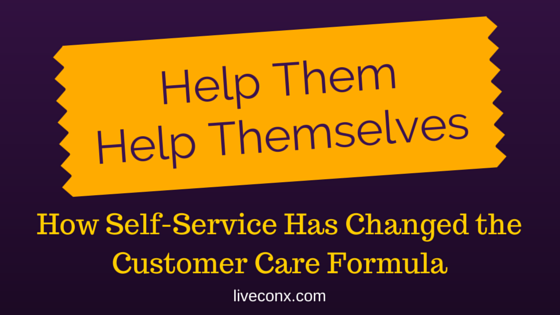How Self-Service Has Changed the Customer Care Formula
Self-service has paved the way for great change in customer service, both in ease of use as well as potential pitfalls that should be avoided.
With the advent of the Internet, customers have more ways to help themselves than ever before. Self-service is on the rise, and with it a changing landscape of customer service that relies more on the consumer rather than droves of agents and attendants on call.
While self-service can be an incredible tool to empower both your customers and your business, care must be taken to make sure you don’t lead them down the wrong path with misinformation.
The Boom of Self-Service
We used to rely on others for many aspects of our daily life, but the rise of computerization and electronics have given people avenues to help themselves in ways that have empowered consumers and freed up businesses to reduce overhead. You can use computers to order drinks at your tableside, purchase products online and even do your own medical research at home. In the information age, there are very few things left that we haven’t streamlined for our own ease of use.
Customer service is no exception to this. According to The Real Self-Service Economy Report, 40 percent of customers surveyed said they’d prefer self-service over human contact, with up to 70 percent expecting a self-service option from a company website.
Benefits of Automation
The self-service trend has many advantages over employee-based services, including:
- Cheaper goods and services due to reduced costs
- Quicker solutions to problems
- Increased productivity from available employees
- Empowering customers to find the answers themselves
By creating solutions that customers can access and find on their own time without the need to consult with an agent, time is saved both on the business end and on the consumer side. This also frees up revenue and cuts down on costs, as employee manpower is freed up to focus on other tasks while the customers help themselves.
Updated and Optimized
One caution you should take when relying more on self-service is ensuring that the materials you supply to the customer are accurate and accessible. Your customer is already having problems — nothing will make them lose faith in your company faster than finding a troubleshooting guide or how-to, and then finding that it is inaccurate or unhelpful.
To this end, you’ll want to make sure that you’re keeping your reference and help materials current with any new updates that come out to your products, including expiration dates on articles to give them an idea of when they were posted. It wouldn’t hurt to include some FAQ’s and basic info that cover the most common problems your customers may face.
Of course, these won’t do your customers any good if they can’t find them! Customers don’t have much patience when it comes to digging through droves of online content, particularly when they’re already frustrated. Keep them happy by making your information readily available and through multiple channels such as Facebook and Twitter.
Make It Easy
We’ve already mentioned the importance of making your materials easy to find, and utilizing search engine optimization is an easy way to do this. Using specific keywords in your materials can help boost its “ranking” in the search engine world to make it appear higher up in search results.
Another important way to make things simple for your customers is to have a clear progression path during the self-help process:
- Make the materials easy to find for whoever needs them
- Ensure that the materials are simple enough for a layperson to read and not filled with technical jargon. Help materials that are too complex are no more helpful than no materials at all
- Using video where possible is powerful tool for demonstrating How-To and Troubleshooting Tips
- Make sure that a live agent or other customer service representative is only a call or click away
Self-service is a process that seems straightforward for those familiar with the material in question, but can be confusing for customers if the process is not delineated clearly. Make it easy for them to find what they need, and if they can’t, give them easy ways to contact somebody who can help them.
Feedback
When you don’t have actual people interfacing with your customers, it can be hard to tell where the areas that need improvement are. Provide your customers with options for comments, reviews and feedback about your self-service process. This will tell you where your weak points are and how you can improve your service to give your customers an experience that is seamless and simple.
To read more information about the benefits of self-service and how it can affect customer satisfaction, check out our free white paper.










